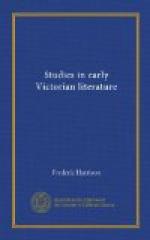It is quite natural and right that Thackeray, Mrs. Gaskell, indeed all who have spoken of the author of Jane Eyre, should insist primarily on the personality of Charlotte Bronte. It is this intense personality which is the distinctive note of her books. They are not so much tales as imaginary autobiographies. They are not objective presentations of men and women in the world. They are subjective sketches of a Bronte under various conditions, and of the few men and women who occasionally cross the narrow circle of the Bronte world. Of the three stories she published, two are autobiographies, and the third is a fancy portrait of her sister Emily. Charlotte Bronte is herself Jane Eyre and Lucy Snowe, and Emily Bronte is Shirley Keeldar. So in The Professor, her earliest but posthumous tale, Frances Henri again is simply a little Swiss Bronte. That story also is told as an autobiography, but, though the narrator is supposed to be one William Crimsworth, it is a woman who speaks, sees, and dreams all through the book. The four tales, which together were the work of eight years, are all variations upon a Bronte and the two Bronte worlds in Yorkshire and Belgium. It is most significant (but quite natural) that Mrs. Gaskell in her Life of Charlotte Bronte devotes more than half her book to the story of the family before the publication of Jane Eyre. The four tales are not so much romances as artistic and imaginative autobiographies.
To say this is by no means to detract from their rare value. The romances of adventure, of incident, of intrigue, of character, of society, or of humour, depend on a great variety of observation and a multiplicity of contrasts. There is not much of Walter Scott, as a man, in Ivanhoe or of Alexander Dumas in the Trois Mousquetaires; and Dickens, Thackeray, Trollope, Bulwer, Miss Edgeworth, Stevenson, and Meredith—even Miss Austen and George Eliot—seek to paint men and women whom they conceive and whom we may see and know, and not themselves and their own home circle. But Charlotte Bronte told us her own life, her own feelings, sufferings, pride, joy, and ambition. She bared for us her own inner soul, and all that it had known and desired, and this she did with a noble, pure, simple, but intense truth. There was neither egoism, nor monotony, nor commonplace in it. It was all coloured with native imagination and a sense of true art. There is ample room in Art for these subjective idealisations of even the narrowest world. Shelley’s lyrics are intensely self-centred, but no one can find in them either realism or egoism. The field in prose is far more limited, and the risk of becoming tedious and morbid is greater. But a true artist can now and then in prose produce most precious portraits of self and glowing autobiographic fantasies of a noble kind.




